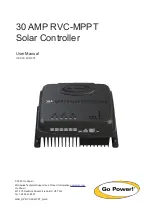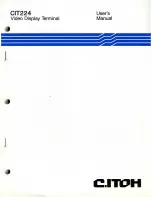
[page 10] | gpelectric.com
STAGE 4: EQUALIZE
Warning: Risk of explosion!
Equalizing vented lead-acid battery may generate explosive gases. So, the battery
compartment must be well ventilated.
Caution: Damage of device!
Equalization can increase the battery voltage to levels that may damage sensitive DC loads.
It is necessary to verify that the allowable input voltage of all system loads is greater than the
equalizing charge set value.
Caution: Damage of device!
Over charge and excessive gas evolution may damage the battery plates and cause active
substances on the battery plate to come off. Equalizing charge may cause damage if voltage
is too high or time is too long. Please carefully check the specific requirements of battery
used in the system.
Certain battery types benefit from regular equalizing charge, which can stir electrolytes, balance battery voltage, and
complete the chemical reaction. The equalize charge increases the battery voltage above a standard voltage, causing
vaporization of battery electrolyte. By default, this happens every 30 days for flooded batteries.
RECHARGE
After the battery is completely charged the charging cycle completes and the battery is allowed to slowly discharge until it
reaches the charge return voltage at which point a new charge cycle is initiated.
CHARGE PARAMETERS FOR VARIOUS BATTERY TYPES
Parameter
GEL
AGM
Flooded
LiFePO4
Custom
High Voltage Disconnect
16.0 / 32.0 V 16.0 / 32.0 V 16.0 / 32.0 V
14.6 / 29.2
8..32 V
Equalize Voltage
-
-
14.9 / 29.8 V
-
8..32 V
Bulk-Absorption Voltage
14.1 / 28.2 V 14.4 / 28.8 V 14.4 / 28.8 V 14.4 / 28.8 V
8..32 V
Float Voltage
13.7 / 27.4 V 13.7 / 27.4 V 13.7 / 27.4 V 14.0 / 28.0 V
8..32 V
Recharge Voltage
13.2 / 26.4 V
8..32 V
Over-Discharge Return Voltage 12.8 / 25.2 V 12.8 / 25.2 V 12.8 / 25.2 V 12.2 / 24.4 V
8..32 V
Under-Voltage Warning Level
12.0 / 24.0 V
8..32 V
Over-Discharge Voltage
11.0 / 22.0 V
8..32 V
Discharge Limit Voltage
10.5 / 21.0 V
8..32 V
Over-Discharge Time Delay
5 seconds
0..120 seconds
Equalize Duration
-
-
120 minutes
-
0..600 minutes
Absorption Duration
120 minutes 120 minutes
120 minutes 120 minutes
10..600 minutes
Equalize Interval
-
-
30 days
-
0..250 days
Temperature Compensation
Factor
-24 mV/°C
-24 mV/°C
-24 mV/°C
-
0..-30 mV/°C
CHARGING STAGES




































